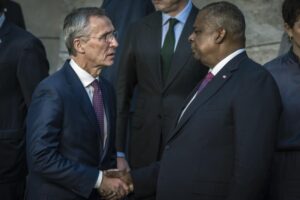NATO is set to agree on a new defense investment pledge this summer that will aim to increase member nations’ spending commitments, the alliance’s leader said Wednesday.
Jens Stoltenberg, the NATO secretary general, said the new pledge could involve taking the current target for spending two percent of GDP on defense and making that a minimum commitment rather than a goal to reach.

“As we continue to adapt our alliance, we need to have the right resources, so ministers also discussed the importance of investing in defense. More countries are now spending at least two percent of their GDP on defense,” Stoltenberg said during a press briefing following the latest NATO ministerial meeting in Brussels. “But what is obvious is that if it was right to commit to spend two percent in 2014, it is even more right now. Because we live in a more dangerous world. There is a full fledged war going on in Ukraine, in Europe, and then we see the persistent threat of terrorism and we see also the challenges that China is posing to our security. So it is obvious that we need to spend more.”
NATO set its current pledge for members to work toward spending two percent of GDP on defense in 2014, with Stoltenberg noting 2022 was the eighth consecutive year the alliance saw an increase in spending, with additional investments totaling $350 billion.
“This trend is expected to continue this year. But more needs to be done. So today, allies discussed how to build on the defense investment pledge, and future commitments beyond 2024,” Stoltenberg said on Wednesday.
Defense Secretary Lloyd Austin told reporters during a separate press briefing on Wednesday the new defense investment pledge is likely to be formalized this July at the next NATO summit in Vilnius, Lithuania.
“We had productive conversations about that pledge and we look forward to working with our valued allies to ensure that we all do even more to invest in our shared security,” Austin said.
Austin said the ministerial meeting at NATO headquarters in Brussels also focused on progress in building ammunition stockpiles and “boosting defense industrial capacity,” as the alliance members continue to provide security assistance to Ukraine.
“NATO allies have dug deep over the past year. Both President Biden and I are deeply grateful. But we still have much more to do. Even as we rush to support Ukraine in the critical months ahead, we must all replenish our stockpiles to strengthen our deterrence and defense for the long term,” Austin said.
Stoltenberg said member nations agreed to new multinational projects during Wednesday’s meeting including one on ammunition warehousing to support prepositioning and stockpiling of ammunition.
At a press conference on Monday ahead of the ministerial meeting, Stoltenberg said NATO just completed a survey of its munitions stockpiles and is using the data to inform plans for increasing production targets.
“The war in Ukraine is consuming an enormous amount of munitions and depleting allied stockpiles. The current rate of Ukraine’s ammunition expenditure is many times higher than our current rate of production. This puts our defense industries under strain,” Stoltenberg said on Monday.
NATO member nations’ waiting time for large-caliber ammunition has increased from a year to 28 months, according to Stoltenberg.
“Orders placed today would only be delivered two-and-a-half years later. So we need to ramp up production and invest in our production capacity,” Stoltenberg said.
Julianne Smith, the U.S.’ ambassador to NATO, said in December that addressing member nations’ declining stockpiles of weapons and munitions sent to Ukraine is a “very serious challenge” (Defense Daily, Dec. 13).
Stoltenberg on Monday noted NATO members have pulled from existing munitions stockpiles to meet security commitments for Ukraine, adding that increased defense spending may help with efforts to replenish those inventories.
“But of course, in the long run, we cannot continue to do that we need to produce more, to be able to deliver sufficient ammunition to Ukraine, but at the same time, ensure that we have enough ammunition to protect and defend all NATO allies, every inch of allied territory,” Stoltenberg said. “So I’m confident that we are now on track, on a path, that will enable us both to continue to support Ukraine, but also to replenish our own stocks. And it just shows the importance of increased defense spending. Because all of this, of course, requires more defense expenditure by NATO allies.”
Stoltenberg also cited the use of multi-year contracts as an option for boosting production capacity for munitions.
“And we have seen several examples of allies now signing multi-year contracts and then the industry have the demand signal they need to make the investments,” Stoltenberg said. “So if you just send a clear signal and also mobilize the financial resources, as we are doing with our pledge to invest more, then the industry have proven extremely capable of producing more.”
Doug Bush, the U.S. Army’s top acquisition official, told reporters in late January that “quite a few [deals] are in the works” that would make use of a new provision included in the fiscal year 2023 National Defense Authorization Act allowing select critical munitions to be procured using multi-year contracts (Defense Daily, Jan. 26).